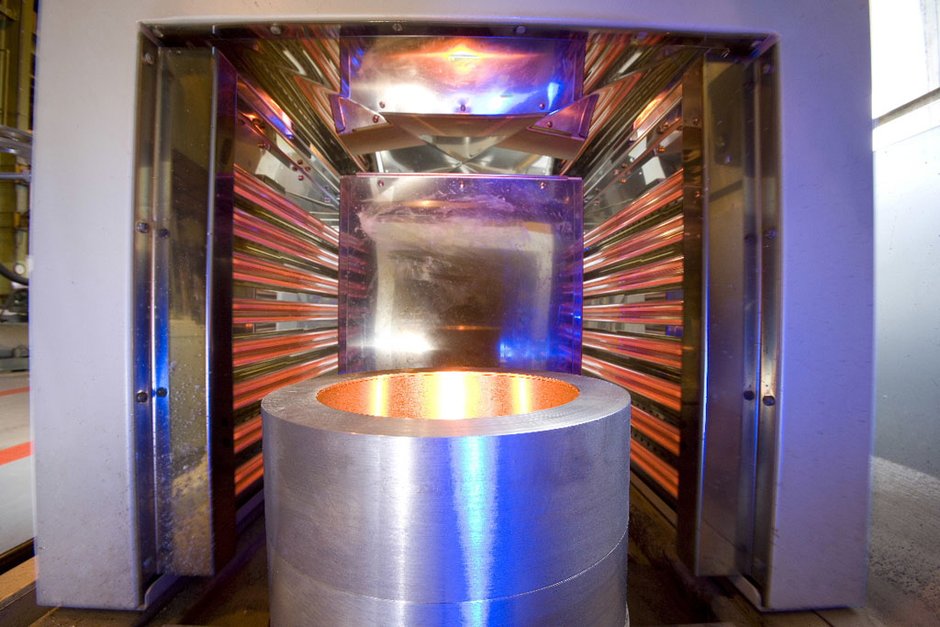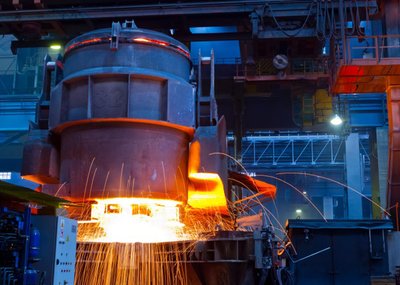Short wave infra-red emitters from Heraeus Noblelight have allowed Mettis Aerospace to reduce the time required for the heating of tools and dies used in the manufacture of high specification titanium aircraft components to one seventh of the heating times required by a previous gas system. This has provided significant energy savings and improved controllability, as well as improved forging practices at the company’s Redditch site.
Mettis Aerospace has decades of experience in the production of highly complex forged and machined, safety-critical aircraft components. This extends from manufacturing the majority of Britain’s aero engine pistons during WWII and pioneering the use of titanium in jet engines to developing alloys for use in Concorde’s structure and skin. Today, Mettis is an important global supplier of complex alloy components to industry giants such as Rolls Royce, Boeing and Airbus.
The manufacture of titanium components at the company’s Redditch factory involves heating titanium preforms to above 900°C and then transferring the heated material into moulding tools. However, it is essential that the tools are pre-heated to above 200°C to allow better material flow and avoid die wear. Previously, die heating had been carried out by an open flame gas system, which directed its heat onto support plates. The gas system remained switched on for 24 hours to ensure that the plates were at the correct temperature before the tools were loaded into position. Heating by this method could take up to ten hours, with limited control of the heat transfer.
When modernization work was carried out in the Redditch facility, particular attention was paid to the tool-heating system and Heraeus was asked to provide an alternative infra-red solution. The short wave system installed consists of two 72kW infrared cassettes, each mounted on an aluminium vertical profile frame. The two frames are positioned on either side of the table used to support the tools, which can be heated in pairs or singly, with heat applied from one side only or from both sides. During heating, a pair of thermocouples measures the temperature of each tool face and this measurement is then used to automatically regulate each cassette’s emitters constantly from 0-100% to maintain the set temperature with optimum energy consumption, maximising the system’s efficiency.
Since installation, the new system has allowed significant energy savings, as it is now only switched on when required, while tool heating times have been reduced, in some cases, from ten hours to just 90 minutes.
As Dr. Xenofon Gogouvitis, the R&D lead at Mettis, reports, “Implementation of an IR heating solution has been a very important step towards an eco-friendly factory. The system’s efficiency has allowed us to reduce energy and time consumption during the pre-heating stage of the dies, while improving overall control of the process. In addition, the absence of any open flames means that we now have a safer and more comfortable working environment.”
Heraeus specialises in the production and application of high quality energy sources covering the electro-magnetic spectrum from ultraviolet to infra-red. It has over 40 years experience in infra-red technology and offers the expertise, products and systems to provide efficient and effective solutions to drying, heating and curing problems throughout industry.
White Metal Bearing Manufacture is More Controllable with Infrared Heat
Michell Bearings, located in Newcastle upon Tyne for more than 80 years, is the premier designer and manufacturer of self-contained white metal (or babbit) bearings for a wide range of marine and industrial applications, such as gearboxes, turbines, pumps and fans.
One of the most important production stages in the manufacture of a white metal bearing is the coating of the parent metal of the bearing surface with the white metal itself. Generally, white metals alloys are composed of tin, copper and antimony. There are various methods of applying the white metal, including dipping the parent metal shell in a hot tinning bath. However, all coating methods require the application of heat to ensure good fluxing and adhesion of the white metal. Directing a naked gas flame onto the parent metal as well as hot tinning can cause a dirty and often hazardous working environment. In an effort to solve the environmental problems, and to achieve greater control over the coating process, Michell have installed an infrared oven at their Newcastle plant. This has been located over an existing flat coating bed and is fitted to an overhead track system.
In operation, the shot-blasted, steel parent metal bearing is loaded onto an existing spinning mechanism on the bed. The infrared oven is then manually moved in place over the bearing before the emitters are switched on. The temperature of the parent metal surface is checked and when this reaches 280ºC, the IR emitters are switched off and the hood is moved away. At this point, the spinning mechanism is activated and the white metal is poured in to be evenly distributed over the required bearing surface by the centrifugal force. The coated bearing is then cooled by an atomised spray of air and water.
Apart from being significantly cleaner and less hazardous than conventional coating methods, the new system has also allowed the coating process to be more controllable, with corresponding improvements in coating quality. Moreover, as the heat is applied only when necessary and is precisely focused onto the bearing surface, the infrared oven has proved more energy-efficient.
Features
- white metal coating of steel bearings
- infrared emitters allow the coating process tob e more controllable
- improvement of quality
- less dangerours than conventional coating
- more energy-efficient
Technical Data
- medium wave infrared heating system
- 32kW, 16 emitters, 2kW each
- control by infrared thermometer
- 280°C surface temperature
###COMPANY_LINK### <link http: www.heraeus-infraredsolutions.co.uk en hng_uk home_4 home_hng_uk.aspx _blank external-link-new-window external link in new>![]() www.heraeus-infraredsolutions.co.uk
www.heraeus-infraredsolutions.co.uk



